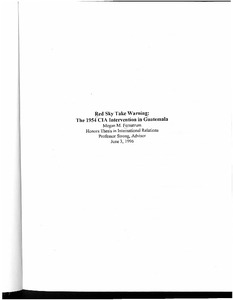| dc.rights.license | In Copyright | en_US |
| dc.creator | Fernstrum, Megan Mehlhope | |
| dc.date.accessioned | 2023-10-20T17:40:43Z | |
| dc.date.available | 2023-10-20T17:40:43Z | |
| dc.date.created | 1996 | |
| dc.identifier | WLURG038_Fernstrum_thesis_1996 | |
| dc.identifier.uri | https://dspace.wlu.edu/handle/11021/36393 | |
| dc.description | There is a typographical error in the pagination -- page 125 does not exist. | en_US |
| dc.description.abstract | In the preceding chapters, I have outlined the causes and conduct of the 1954 CIA intervention into Guatemala and assessed it in terms of its justification. I have come to the conclusion, which has incidentally been widely accepted among political observers, that the 1954 intervention cannot in fact be labeled as a justifiable intervention. In addition, the 1954 intervention actually caused a number of concrete disadvantages for both Guatemala and the United States foreign policy establishment which were enumerated in Chapter Five. Looking at these results, one remaining question about the 1954 intervention naturally arises: why did intelligent, capable leaders who were generally well intentioned administer an unjustifiable intervention which resulted in disadvantages for both the United States and Guatemala? The answer to the preceding question can never be known conclusively. The exact decision making stimuli for the 1954 intervention can only be uncovered through the first hand knowledge of those few men who participated directly in the decision-making process. Unfortunately, the vast majority of these men are deceased. Thus we are left to piece the stimuli together based on the few accounts which they left behind and the general conditions which existed during the period of the first Eisenhower administration. An examination of these sources points to three factors which functioned as stimuli in the 1954 intervention decision process. These three factors vary in their immediacy to the actual decision to take action with the third of the three stimuli being the most influential. The three causes can be simply stated as administration connections to the United Fruit Company, the phenomena of McCarthyism which swept the country in the early 1950's, and the heightened level of Cold War tensions during the same period. [From Conclusion] | en_US |
| dc.format.extent | 131 pages | en_US |
| dc.language.iso | en_US | en_US |
| dc.rights | This material is made available for use in research, teaching, and private study, pursuant to U.S. Copyright law. The user assumes full responsibility for any use of the materials, including but not limited to, infringement of copyright and publication rights of reproduced materials. Any materials used should be fully credited with the source. | en_US |
| dc.rights.uri | http://rightsstatements.org/vocab/InC/1.0/ | en_US |
| dc.subject.other | Washington and Lee University -- Honors in International Relations | en_US |
| dc.title | Red Sky Take Warning: The 1954 CIA Intervention in Guatemala | en_US |
| dc.type | Text | en_US |
| dcterms.isPartOf | WLURG038 - Student Papers | en_US |
| dc.rights.holder | Fernstrum, Megan Mehlhope | en_US |
| dc.subject.fast | United States | en_US |
| dc.subject.fast | Guatemala | en_US |
| dc.subject.fast | International relations | en_US |
| dc.subject.fast | Cold War (1945-1989) | en_US |
| dc.subject.fast | Eisenhower, Dwight D. (Dwight David), 1890-1969 | en_US |
| local.department | International Relations | en_US |
